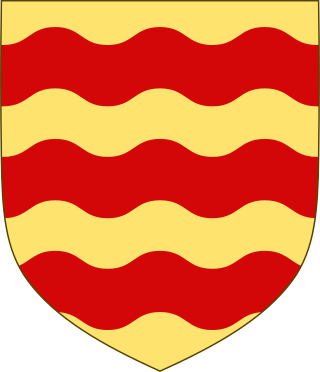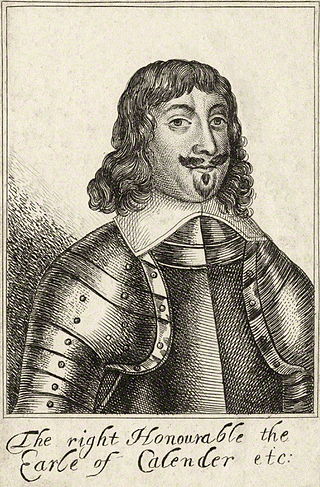
Earl of Erroll is a title in the Peerage of Scotland. It was created in 1453 for Sir William Hay. The subsidiary titles held by the Earl of Erroll are Lord Hay and Lord Slains (1452), both in the Peerage of Scotland. The Earls of Erroll also hold the hereditary office of Lord High Constable of Scotland. The office was once associated with great power. The Earls of Erroll hold the hereditary title of Chief of Clan Hay.

Earl of Perth is a title in the Peerage of Scotland. It was created in 1605 for James Drummond, 4th Lord Drummond. The Drummond family claim descent from Maurice, son of George, a younger son of King Andrew I of Hungary. Maurice arrived in Scotland on the ship which brought Edgar Ætheling, the Saxon claimant to the crown of England after the Norman Conquest, and his sister Margaret to Scotland in 1068. Maurice was given lands in Lennox (Dunbartonshire), together with the hereditary stewardship of the county. The Hungarian Prince theory has been discounted as no evidence of any relationships exists in written records or DNA. "The Red Book of the Menteiths" clearly discounts the Hungarian Prince as a myth likely formed to give status to the Drummond origins. The Drummonds in the 12th Century were allied to the Menteiths – their early fortunes developed through the relationship. Indeed, one "Johannes De Drumon", said to have died in 1301, was buried in Inchmahome Priory which was founded by the Menteiths. His successor John Drummond, the 7th Steward, was deprived of the lands and retired into Perthshire.

Earl of Southesk is a title in the Peerage of Scotland. It was created in 1633 for Sir David Carnegie, an Extraordinary Lord of Session. He had already been created Lord Carnegie of Kinnaird in 1616 and was made Lord Carnegie, of Kinnaird and Leuchars, at the same time he was given the earldom. These titles are also in the Peerage of Scotland. The earldom is named after the River South Esk in Angus. Carnegie's younger brother John Carnegie was given the corresponding title: earl of Northesk. The earl of Southesk also holds the Scottish feudal title of Baron of Kinnaird and is a baronet in the Baronetage of Nova Scotia. Kinnaird Castle, Brechin, has been the home of the earls of Southesk for several hundred years.

Earl of Gowrie is a title that has been created twice, once in the Peerage of Scotland and once in the Peerage of the United Kingdom, both times for members of the Ruthven family. It takes its name from Gowrie, a historical region and ancient province of Scotland. On 23 August 1581, William Ruthven, 4th Lord Ruthven, was created Earl of Gowrie by James VI, King of the Scots. He was executed for high treason, attainted and his peerages forfeited on 28 May 1584. Two years later in 1586, the attainder was reversed and his son, the second Earl, was restored as Earl of Gowrie and Lord Ruthven, but both peerages were forfeited after the alleged plot and subsequent death of the second Earl's younger brother, the third Earl, in 1600.

Earl of Seaforth was a title in the Peerage of Scotland and the Peerage of Ireland. It was held by the family of Mackenzie from 1623 to 1716, and again from 1771 to 1781.
The titles of Viscount of Melfort and Lord Drummond of Gillestoun were created in the Peerage of Scotland on 14 April 1685 for John Drummond, second son of James Drummond, 3rd Earl of Perth, with remainder to the heirs male of his body by his second marriage, to Euphemia Wallace, failing whom to the heirs male of his body whatsoever. He was further created, on 12 August 1686, Earl of Melfort, Viscount of Forth and Lord Drummond of Riccartoun, Castlemains and Gilstoun, also in the peerage of Scotland, and with a similar remainder.

Earl of Panmure was a title in the Peerage of Scotland. It was created in 1646 for Sir Patrick Maule, a former Gentleman of the Bedchamber to James VI and loyal follower of Charles I. He was made Lord Brechin and Navar at the same time, also in the Peerage of Scotland. Both titles were forfeit by the attainder of the 4th Earl in 1716 on account of his participation in the Jacobite rising of 1715. The heirs apparent to the Earldom were styled Lord Maule. The seat of the Earldom was Panmure House, built in the 17th century near Monikie, Angus.
Earl of Callendar was a title in the Peerage of Scotland. It was created in 1641 for James Livingston, 1st Lord Livingston of Almond, a younger son of Alexander Livingston, 1st Earl of Linlithgow, along with the subsidiary title Lord Livingston and Almond. The 4th Earl later inherited the more senior Earldom of Linlithgow from his uncle, with which title the Earldom of Callendar was merged until its forfeiture by attainder in 1716. The seat of the Earls of Callendar was Callendar House in Falkirk.

James Hay, 15th Earl of Erroll styled Lord Boyd from 1728 to 1746, was a Scottish nobleman and the son of William Boyd, 4th Earl of Kilmarnock.

Callendar House is a mansion set within the grounds of Callendar Park in Falkirk, central Scotland. During the 19th century, it was redesigned and extended in the style of a French Renaissance château fused with elements of Scottish baronial architecture. However, the core of the building is a 14th-century tower house.
Alexander Livingston, 5th Lord Livingston of Callandar PC was the guardian of Mary, Queen of Scots, during her childhood.

James Livingston, 1st Earl of Callendar, was a Scottish army officer who fought on the Royalist side in the Wars of the Three Kingdoms.
George Livingston PC was a military officer and third Earl of Linlithgow.
Alexander Livingston, 1st Earl of Linlithgow PC was a Scottish nobleman, courtier, and politician. His wife was Helenor Hay, Countess of Linlithgow who was a Royal tutor.
Helenor Hay, Countess of Linlithgow was a Scottish courtier and writer.
William Livingston, 4th Lord Livingston of Callandar was a Scottish nobleman.

James Livingston, 5th Earl of Linlithgow, 4th Earl of Callendar was a Scottish nobleman who was convicted of high treason and forced to forfeit his estates and all his titles to the Crown.
Alexander Livingston, 2nd Earl of Linlithgow PC was a Scottish nobleman.
Alexander Livingston, 3rd Earl of Callendar was a Scottish nobleman.

William Keith, 2nd Earl of Kintore, was a Scottish nobleman.








